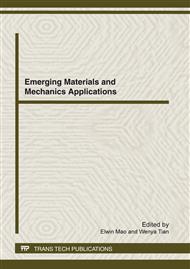[1]
Jiye Li and Feng Zhang, Modern engineering materials practical manual, J. China building materials industry press, (2007) 764-773.
Google Scholar
[2]
Qi Chao, Shuangbao Bao and Wangcai Dong, The research present situation and development trend of environment fire-retardant particle board, J. Wood Processing Machinery. 4, (2004) 14-16.
Google Scholar
[3]
Yingjian Wang, Study of the best formula for non-halogen inorganic flame retardants, J. Chemical Industry Times. 2(10) (2008) 34-38.
Google Scholar
[4]
Peigang Dai, Zhipeng Liu, Yingjie Chen and Yang Zhang, Current Situation Development of Inorganic Flame Retardant, J. GuangDong Chemical Industry, 35(18) (2008) 62-64.
Google Scholar
[5]
Cheng Qiang and Liu Zhijun, Research on inflaming retardant of the wood materials, J. 2 (2001) 38-41.
Google Scholar
[6]
Yingjie Zhang and Jizhao Liang, Study on flow properties of PP/Al(OH)3/Mg(OH)2 flame-retarding composites, J. Plastics and Technology, 36(8), (2008) 36-39.
Google Scholar
[7]
Shen K K. Zinc borate as a flame retardant in halogen-free wire and cable systems, J. Plastics Compounding, 11(17) (1988) 26.
Google Scholar
[8]
Fabien Carpentier, Serge Bourbigot, Michel Le Bras and René Delobel. Michel foul on charring of retarded ethylene viny acetate copolymer-magnesium hydroxide/zinc borate formulations, J. Polymer Degradation and Stability, 69(1) (2000) 88.
DOI: 10.1016/s0141-3910(00)00044-6
Google Scholar
[9]
Serge Bourbigota, Michel Le Brasa, Robert Leeuwendalb, Kelvin K. Shenc and David Schubertc. Recent advances in the use of zinc borates in flame retardancy of EVA, J. Polymer Degradation and Stability, 64(3) (1999) 420.
DOI: 10.1016/s0141-3910(98)00130-x
Google Scholar
[10]
Wei Zhao and Li Wang, The Synergism Effect of Zinc Borate on Fire Retardancy of Low Density Polyethylene, J. Plastics and Technology, 34(1) (2006) 40-43.
Google Scholar
[11]
Zhang Lin, Development and flame characteristics analysis of a novel Fiber-based Decorative Wall Panel. Zhejiang Sci-Tech University Master Dissertation. (2010).
Google Scholar
[12]
Chen Jishuang, Qin Zuodong, Zhang Lin, Tang Zhirong, Xu Miaofang, Zhou Renni, Zhou Ying, U.S. Patent 13/019, 315. (2011).
Google Scholar
[13]
Lu An, Qing Gao and Zushun Xu, The flame-retardant application of Al(OH)3 and Its Composites in Polymers, J. Insulating Materials, 41(1) (2008) 30-36.
Google Scholar
[14]
Qianwei Xu and Jinwang Ruan, Polymer Materials Science and Engineering, J. 2 (1990) 61-66.
Google Scholar
[15]
Laibing Li, Study on flame retarding with aluminum hydroxide in the composites of epoxy resin, [D], Centre South University, (2005).
Google Scholar


